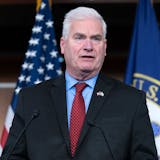At first glance, a Nov. 5 ballot question asking St. Paul voters to shift city elections to even-numbered presidential election years seems certain to achieve its backers’ goal: Increase voter turnout in Minnesota’s capital city.
In 2016, more than 140,000 St. Paul residents cast votes. And in 2020, more than 150,000 voted. Those numbers were about three times greater than the people who decided St. Paul’s mayor and City Council elections in 2021 and 2023.
“I certainly think that higher turnout is the gold standard for elections,” said Peter Butler, who has led petition drives in 2017 (unsuccessful) and 2023 (successful) to put a change before voters. “As a democracy, that is your primary measure whether government is representative to the people.”
But City Council President Mitra Jalali fears that the ballot year would create a ballot jumble that would drown out city issues and hinder the ability of candidates to capture voters’ attention. For instance, she asked, what would happen to St. Paul’s system of ranked-choice voting on a ballot crowded with presidential and congressional candidates, too?
“Our voters actually stand to be disenfranchised under this proposal,” said Jalali, who theorized that including candidates for president, Congress and statewide races could require limits on the number of City Council hopefuls placed on the ballot. Or, she said, local issues may not get full consideration in the noise of an election for the White House.
“I am concerned that it would bury [local issues] as important as housing and transportation,” Jalali said.
Mayor Melvin Carter, too, said the issue isn’t as simple as just getting more people to vote.
“Local issues have the most immediate impact on our lives, but often garner the least attention,” Carter said in a statement last week. “While I am concerned that critical issues like neighborhood safety, trash collection and street maintenance cannot compete with the clamor of a national campaign cycle, the city will follow the will of the voters with regard to this ballot measure.”



